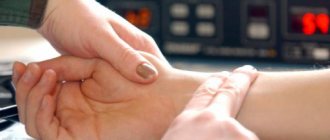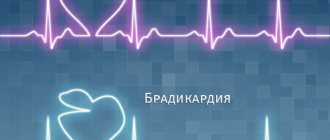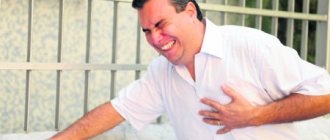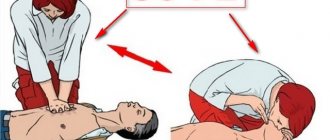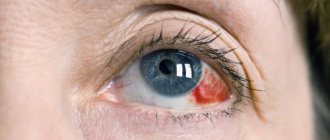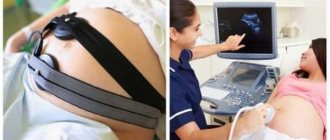The fatal pulse for a person is calculated according to the “220-age” principle, but official medicine believes that a pulse rate of 160-170 beats per minute can already lead to death. If such increases occur only after active physical activity, then they do not pose a danger to life, but achieving the indicated numbers at rest is a reason to call an ambulance.
Before death, a person’s pulse, on the contrary, decreases to its maximum – reaching 20-40 beats per minute, and may not be palpable at all. This is pre-agony, after which a short-term increase in heart rate is possible. First aid for a critically high pulse can be provided even without medical education - help the patient take the correct position, give Validol or Anaprilin tablets, and measure blood pressure.
Lethal pulse for a person: at what indicators can you die?
Lethal heart rate indicators for a person, at which one can die, are calculated using the standard formula:
220 – human age
For example, a man is 50 years old, which means that his deadly pulse rate is 170 beats per minute (220-50). It must be remembered that heart rate is considered an individual indicator, so the above formula can be used to obtain only average values - someone lives comfortably at 60-70 beats per minute, and for some people 90-100 will be the norm.
Official medicine believes that a pulse of 160-170 beats per minute can be fatal because:
- the heart's need for oxygen increases;
- the amount of circulating blood is not able to deliver the required “portion” of oxygen to the organ;
- acute hypoxia and heart failure occur.
Heartbeat of a healthy person
Contraction of the heart muscle causes expansion and contraction of blood vessels. The jerky vibrations of the arteries are called the pulse. You can find and count it using palpation or special measuring instruments. They feel the pulse before death in different places.
- wrist;
- elbow bend;
- armpit;
- neck, where the carotid artery passes;
- inner thigh at the groin;
- under the knee, with the leg straightened.
The pulse helps monitor a person's health. The older you are, the lower your heart rate. The stronger and larger the heart muscle, the fewer contractions are required to ensure normal blood circulation.
Normal heart rate for different age categories:
| Age | Beats per minute |
| Newborn | 120-160 |
| 1 year | 80-140 |
| 3 years | 75-120 |
| 7 years | 75-110 |
| Adult | 60-100 |
| Athletes | 40-60 |
Various factors influence heart rate:
- stress;
- health status;
- food and alcohol;
- physical activities;
- Times of Day.
Note. Excessive heart rate can be observed during physical activity and is normal. In other conditions, frequent contraction of the heart muscle requires correction.
Maximum heart rate
Danish scientists claim that a rapid resting heart rate indicates a risk of premature death. In this case, a person may not have heart pathologies. The researchers analyzed more than 2 million people before reaching their final conclusion. Having compared the numbers, scientists concluded that a rapid pulse before death is a kind of signal. More than 80 beats per minute increases the risk of death by 3 times.
At what pulse does a person die is a pressing question for many people. There are certain maximum and minimum values. These numbers are individual for each organism. In cardiology, a special formula is used to calculate high parameters. The person’s age is subtracted from the number 220 and the maximum possible heart rate is obtained. A pulse of 160-170 beats per minute is considered critical and can be fatal if left untreated.
Symptoms accompanying rapid heartbeat:
- high pressure;
- pulsation in the limbs;
- noise in ears;
- increased sweating;
- nervousness.
High blood pressure and pulse before death are accompanied by chest pain, darkening of the eyes, and numbness in the fingers. This condition requires emergency care.
Before the doctors arrive, it is necessary to give the patient tincture of valerian, put Validol or Anaprilin under the tongue. You need to measure your blood pressure. If the indicators are high, take Verapamil, Metoprolol.
Dangerous pulse for humans: causes
The causes of a dangerous pulse for a person can be:
- alcohol, drug addiction;
- acute lack of potassium and magnesium in the body;
- food poisoning, poisons, toxic gases;
- mental or nervous disorders;
- pathologies of the endocrine system that occur in severe stages.
Critically high pulse rates can also occur against the background of coronary heart disease, cardiosclerosis, myocarditis, heart defects of various nature and origin, acute blood loss, traumatic/mechanical damage to the heart muscle. Typically, the listed diseases are under the control of doctors - patients are registered, undergo regular examinations/diagnosis, and take specific medications on a regular basis.
But if there is no therapy, the patient does not get rid of bad habits and does not comply with the recommendations/prescriptions of the attending physician, then the death outcome against the background of the highest possible pulse rate is quite predictable.
How to feel a person's critical pulse
You can feel the critical pulse for a person by measuring the indicator in a standard way - on the wrist (from the inside), on the neck or in the groin area, on the elbow. Signs that you should check the pulse and take measures to save the person:
- blood pressure rises sharply;
- there are complaints of tinnitus;
- extremities begin to go numb and become cold (specifically, fingers and toes);
- large drops of sweat appear on the face.
The person begins to get nervous, he may be overcome by an attack of fear of death, and shortness of breath occurs. Complaints about darkening of the eyes and pain in the chest (the area of the anatomical location of the heart) are a signal that you need to immediately call an ambulance, because the patient requires resuscitation measures.
What might the pulse be like before death?
Before death, a person’s pulse slows down and can reach 20-40 beats per minute - this is the so-called preagonia. The condition is characterized by other symptoms:
- pain sensitivity is completely absent;
- consciousness is lost;
- pupils are constricted;
- the respiratory rate is 2-6 per minute and often cannot be determined at all.
In general, the transition from life to death is called a terminal state in medicine. It is characterized by the extinction of body functions, but not simultaneously, but gradually, and this is what allows, in some cases, to bring the patient back to life. After preagonia, when the pulse rate slows down, there are 3 more stages until biological death:
- terminal pause - the pulse cannot be felt at all, cardiac and respiratory arrest is observed, the duration of the stage is several seconds;
- agony - the body seems to be returning to life and this will be the last “outbreak”: the pulse and heartbeat quicken, blood pressure rises, breathing intensifies;
- clinical death - signs of life are completely absent.
What is the pulse when a person dies: causes, possible symptoms and manifestations
What provokes a decrease in heart rate to 50 beats per minute, why can this value be both optimal and dangerous? Unsafe causes of low heart rate include:
- pathologies of the conduction system and other heart diseases;
- weakening of the sinus node, which prevents the heart from beating faster;
- endocrine (diabetes mellitus, hypothyroidism, etc.), tumor diseases (cancerous neoplasms);
- neurotic conditions causing “tachy-brady” syndrome (alternating bradycardia and rapid pulse);
- chronic poisoning with vapors from chemical or pharmaceutical production;
- lack of myocardial fitness, physical inactivity.
Dying blood pressure - at what pressure does a person die?
The last factor is classified as dangerous, since modern research proves that no fewer people die from the consequences of physical inactivity than from smoking. This may seem counterintuitive, since low heart rate is also observed in trained athletes.
But the difference is that trained people tolerate physical stress much better, and people suffering from physical inactivity react to any effort with a sharp increase in heart rate, increased blood pressure, shortness of breath and other severe symptoms.
Physiological bases for a rare heart rate at rest:
- high level of training of the myocardium and the body as a whole;
- congenital predisposition to a slow heart rate;
- hormonal changes (especially in females);
- prolonged hypothermia (the body seems to go into “hibernation”).
Causes of low heart rate
The normal pulse rate (heart rate) range is 60 to 90 beats per minute. If their numbers are lower, this condition is called bradycardia. High blood pressure (hypertension) – blood pressure numbers more than 140/90 mmHg. Art. Pulse is a reflection of heart contractions, so their frequency should be the same.
Normally, the body’s adaptive reactions are configured in such a way that when pressure increases, the heart rate and pulse should simultaneously increase. Dissociation (multidirectionality) between these indicators, when the pressure rises and the pulse decreases, indicates a failure in the regulation of the cardiovascular system.
This can be due to both physiological (natural) reasons and pathological conditions (diseases). They are described in the table.
Conventionally, the causes of bradycardia can be divided into 3 groups: physiological, pathological cardiac, pathological non-cardiac. If we talk about physiological factors leading to a decrease in heart contractions, these include:
- Hypothermia, in which the heart reflexively begins to beat less frequently because the body requires less oxygen under hypothermia conditions.
- Body fitness, such as that of athletes. Their heart muscle gets so used to the stress that in a calm state it simply relaxes.
- Heredity, which determines the individual physiological characteristics of the organism.
A weak pulse can also be observed in the morning in the first minutes of awakening in completely healthy people. But bradycardia also develops with various pathologies of the cardiovascular system, especially those that affect the elements of the cardiac conduction system responsible for rhythm. Such diseases include:
- atherosclerosis;
- myocardial infarction and the presence of post-infarction cicatricial changes in the heart muscle;
- low pressure;
- endocarditis, myocarditis.
Probable etiology of the problem
The reasons that cause a state of high blood pressure with a decreased rhythm of the heart muscle may be the following:
- 1. Heart pathologies.
- 2. Diseases of the thyroid gland and endocrine system. Hormonal imbalance often causes difficulties in the functioning of the vascular system.
- 3. Frequent use of medications that have side effects on the heart.
- 4. Adaptation of patients with hypertension during the period of change of place of residence and changes in temperature.
- 5. Excessive fatigue and increased mental stress.
Possible symptoms and manifestations
A decrease in heart rate below normal is not always accompanied by complaints due to arterial hypertension (high blood pressure) - about 15% of patients are able to perform their usual work. Severe deviations from the norm not only disrupt the general condition, but also threaten life. Possible symptoms are described in the table.
| Headache (temple, back of head) | Dizziness, fainting |
| Muscle tremors throughout the body | Marked general weakness |
| Nausea, vomiting | Feeling short of air |
| Pain in the heart area | Feeling of heartbeats stopping |
In order to assess the extent to which the patient’s condition is impaired, it is necessary to measure the pulse and pressure. Mechanical tonometers show only blood pressure, while electronic ones show both indicators. You can count the pulse by placing your fingers on any artery (this could be the inner surface of the forearm or shoulder, or the femoral-inguinal area).
In patients with a pulse less than 50 beats per minute, loss of consciousness, acute cerebrovascular accident and stroke, heart attack, pulmonary edema, sudden cardiac arrest and death are possible.
Diagnosis and treatment
This is necessary for the most accurate diagnosis, since indicators that overestimate or significantly lower the established standards are already indicative of the course of a particular disease.
The easiest way to determine a low heart rate at home is to count it. In the hospital this is done more accurately by performing an electrocardiogram.
Ultrasound examination of the heart gives good results. To assess the increase in the frequency of organ contractions, load bicycle ergometry is used.
Treatment of low heart rate is carried out in a hospital setting. In case of severe clinical manifestations, in order to increase the heart rate, the patient is prescribed:
- Atropine intramuscularly or intravenously.
- Isadrin (drip, in glucose solution).
- Isoproterenol in a dropper.
- Alupent.
If the signs of a low heart rate are not pronounced, the patient will be helped to increase the pulse to a normal level by taking belladonna, eleutherococcus or ginseng. It's good to drink a cup of coffee. However, with atherosclerosis, Raynaud's disease, high blood pressure, and coronary heart disease, the frequency of its contractions cannot be increased in this way.
Pulse in older people: normalizing heart rate
When the heart muscles contract and blood is pushed out of the heart into the arteries, impulses occur - this is the pulse. Its frequency is determined by the number of beats per unit of time. In a healthy adult, this value should normally be about 60-80 beats per minute, but the pulse in older people has different indicators.
Pulse in an elderly person as an important indicator of the body
The human pulse is a jerky oscillation of blood vessels in the human body against the background of contraction of the heart muscle. We feel the pulse as a beat in the large arteries. The best time to measure is in the morning. Throughout the day, our heart rate can change several times. The normal heart rate of a healthy adult is 60-80 beats per minute.
At different periods of life, a person has different pulse rates. The most active pulse is in infants, then it gradually decreases and reaches 80 beats by adulthood. And in older people it slows down completely and can reach up to 60 beats per minute. Only before death there can be a sharp jump to 160.
What does a person’s pulse depend on?
In older people, the pulse is very sensitive to various conditions. The indicators are influenced by:
- age, as well as what gender and height the person is;
- intensity of loads and level of training;
- how functional the body is and how it adapts to different situations;
- the presence of stress or difficult experiences;
- chronic diseases and protective qualities of the body;
- Times of Day;
- nutrition and bad habits.
An increase in heart rate intensity is always explained by obvious reasons. To increase your pulse by 10-12 beats, just change the position of your body. For example, you were lying down and suddenly stood up. With minimal changes, the heart rate immediately returns to normal.
There are different norms for different ages:
- For newborns and infants, the norm will be 140 beats, and by one year the pulse will be 130 beats.
- At two years old, a child has about a hundred beats per minute.
- In early childhood, from 2 to 7 years, about 90 beats per minute.
- In adolescence, by the age of 14, the pulse reaches the level of an adult - 80 beats.
- 72 strokes in middle-aged people.
- An elderly person's pulse per minute is 65 heartbeats.
Male and female heart rates also differ. Men have a calmer pulse than women. Height also affects your heart rate. In tall people it is usually a little calmer than in short people.
What should be the heart rate of older people during physical activity?
The pulse rate is affected by blood circulation and pressure in the blood vessels. When playing sports, your blood pressure increases, thereby increasing your heart rate.
But if a person trains constantly and the body gets used to physical activity, then there is a tendency to reduce the frequency outside of training.
In an adult, up to old age, the pulse depends more strongly on physical fitness than on age indicators.
Your heart rate will vary at different times of the day. The lowest levels are in the morning and before bedtime, and the most active frequency will be in the evening. Sometimes, when a person is dreaming, you can observe how the closed eyes move. At such moments, the heart rate can be equal to the level of the heart rate when playing sports.
When a person is lying down, the pulse is calmer than in other body positions. This suggests that when our body is not excited, heart contractions are less frequent, which has a beneficial effect on our health. An increase in heart rate is provoked by stress and strong feelings, as well as by eating and drinking alcohol.
If an older person begins to exercise, there are several important things to consider. During physical activity, you should ensure that your heart rate does not exceed the permissible values. Calculating your maximum is very simple: you need to subtract your age from 220. For example, if you are 60, then your maximum heart rate should be 160.
Does the heart rate change in older people when they are sick?
When the results of pulse measurements are outside the normal range, this may indicate various disorders in the body. If the pulse rate of an elderly person is higher than normal, this indicates a diagnosis such as tachycardia. This disease requires mandatory treatment.
If the readings are below normal, this may indicate bradycardia. The negative impact of this disease is also great, and therefore requires constant monitoring. If your heart rate is too slow, you should seek medical attention.
If the body temperature is high, then the pulse of an elderly person increases. With each degree the pulse increases by 10 beats.
It is necessary to pay attention to the pulse rhythm in an elderly person. When the pulse is clear, even and the intervals between beats are equal, this indicates a good state of health. If the opposite is true, then an elderly person may have an arrhythmia. It comes in different types:
- Extrasystole - the presence of an extra beat;
- Atrial fibrillation is an uneven pulse;
- Paroxysmal tachycardia is a very active and sharp beating of the heart.
The pulse should be normal and any abnormalities should be monitored and treated as needed. Currently, it is becoming a worldwide practice to make a diagnosis based on pulse indicators.
If an elderly person's pulse beats too quickly, then we can talk about the possibility of diseases such as anemia, heart defects, thyrotoxicosis and other diseases.
If, on the contrary, the pulse is rarer and slower, then there is a possibility of the following diseases: problems with the thyroid gland, increased intracranial pressure after injuries, jaundice, brain tumors and others.
How to measure heart rate in older people correctly
Of course, older people do not have special knowledge and skills to diagnose themselves by heart rate. Only a professional can do this. But everyone should learn to measure correctly. To do this correctly, you need to know a few rules.
The most convenient place to measure an elderly person's pulse is the wrist. Although you can listen to the pulse in other parts of the body. To listen for a pulse, you bend your wrists slightly and cup it with your other hand. Then place your fingers (index, middle and ring) on the artery one strip at a time. When you press on the artery, you will feel light shocks.
Source: https://zabota-43.ru/zdorove/kakoj-puls-pri-smerti-cheloveka-kak-pravilno-ego-izmerit.html
How to alleviate the condition if a person’s maximum permissible heart rate is
If a person has the maximum permissible pulse, then you need to call an ambulance and try to alleviate his condition:
- ensure the flow of fresh air - open the windows, unbutton or remove/cut clothes: nothing should restrict the patient’s chest or neck;
- position the person in a horizontal position so that the head is slightly higher in relation to the body and legs;
- wash it, sprinkle your face with cool water;
- give tincture of valerian or motherwort to drink;
- Place a Validol or Anaprilin tablet under your tongue.
It is highly advisable to measure the patient’s blood pressure before the doctor arrives. If it is elevated, then it is advisable to give him a tablet of Captopril, Verapamil or Metoprolol.
If signs of clinical death appear, then only 4 minutes remain in order to save a person with the preservation of all functions - as soon as problems begin in the blood supply to the cerebral cortex, the vital activity of the organs is reduced for a maximum of another 7 minutes, but after 5 minutes the brain cells begin to die brain against the background of acute oxygen starvation. What you can do:
- artificial respiration;
- heart massage.
The manipulations are performed according to a clear formula - for 30 clicks (“pumping” of the heart), 1 inhalation and exhalation are made. As soon as the pulse begins to be felt, a reaction to light appears, resuscitation can be stopped, because this indicates the patient’s return to life, although there may be no breathing for a few more minutes.
The fatal pulse for a person is calculated on a strictly individual basis, but an indicator of 160-170 beats is already considered critical. If the rate reaches 200 beats per minute at rest, then you need to call an ambulance - resuscitation measures are required to avoid death. Before the arrival of specialists, even a person without medical education can provide assistance to the patient.
Both scary and awkward
As the medical encyclopedia says, death is the irreversible cessation of the body’s vital activity, the natural and inevitable final stage of its individual existence.
In warm-blooded animals and humans, it is primarily associated with a complete stop of breathing and blood circulation. In fact, death can consist of several stages and terminal conditions. And the signs of biological death (when all physiological processes in cells and tissues are stopped) were constantly refined with the development of medicine. This question is vital in the truest sense of the word. And the point is not that a person can be buried alive (in our time this is difficult to imagine, but in the past it happened regularly) - the exact confirmation of death determines when resuscitation measures can be stopped, as well as organs removed for further transplantation. That is, saving someone's life.
Imaginary death: what is lethargic sleep Read more
What happens to the body when all vital processes stop? The brain cells are the first to die. They are most sensitive to lack of oxygen. However, some nerve cells can live so long that scientists are not entirely sure whether such a person should be considered dead? After all, he seems to continue to perceive something and (who knows!), perhaps, think!
Swedish scientists from the Karolinska Institute conducted research and came to the conclusion: the brain activity of the deceased fluctuates greatly. Either it is near zero, which indicates death has occurred, then it suddenly rises to a value corresponding to the state of wakefulness. And then it falls again. What happens in the brain of the deceased remains unclear. It is possible that he has some thoughts and feelings even after his heart has stopped beating.
Scientists suggest that the nerve cells of the brain at this moment emit the last impulse. This also explains the phenomenon of experiences in a state of clinical death - the feeling of flight, light at the end of the tunnel, meeting with a higher being, etc. “It is unlikely that a person is conscious during such brain activity,” says Lars Ohlsson, a researcher from the Karolinska Institute. “The only people who have come close and can say anything about it are those who have had near-death experiences.” And according to believers, a flash of brain activity corresponds to the moment when the soul of the deceased leaves the body.
Article on the topic
Locked brain. Do people in a coma hear everything, think and can communicate? If it is not possible to ask the deceased what he is thinking about, then seeing his movements and hearing sounds is quite possible. The fact is that after death the body twitches for a couple of seconds and spasms occur in it. The muscles then relax, returning to their original state, and this may be perceived as moving or twitching of the limbs. There have been cases where a person has given up the ghost and his chest moves, giving the impression that he is still breathing. The reason is that after death, the nervous system sends signals to the spinal cord “by inertia” for some time.
Sometimes the dead make strange sounds, which, of course, horrifies the relatives and those gathered to see him off on his last journey. These sounds sound like a groan, a whistle, a sigh, or a strangled cry. There is no mysticism here: the body of every person is filled with liquids and gases. Once the body begins to decompose, additional gases are created that need an outlet. They find it through the trachea. Hence the sounds.
There is even “inappropriate behavior” on the part of deceased men, when those present notice they have an erection. The awkwardness and bewilderment are understandable, but so is the phenomenon itself. After the heart stops, blood can move to the pelvic area and cause temporary swelling of the penis.
How is lethargic sleep recognized and distinguished from death? More details
